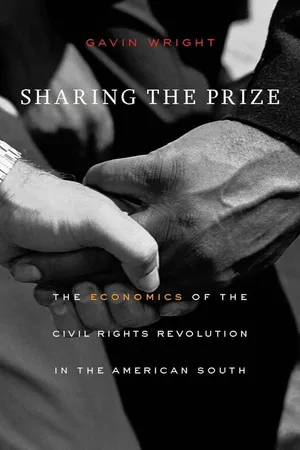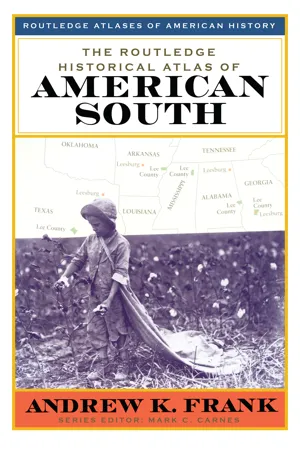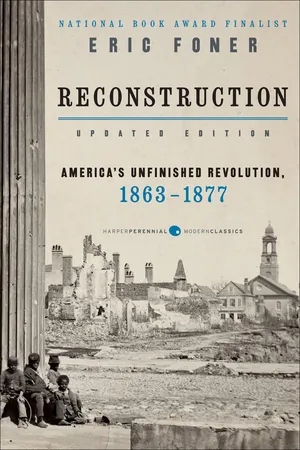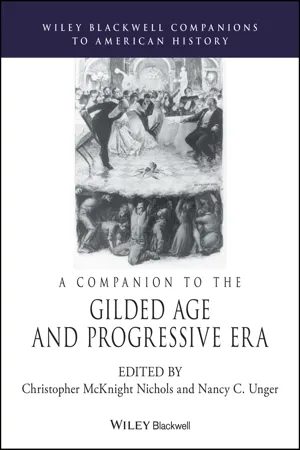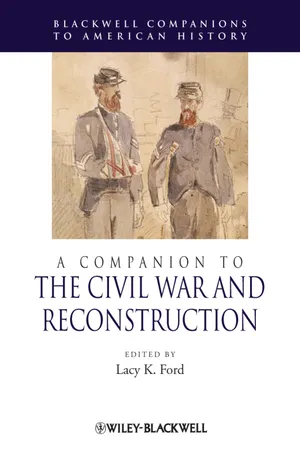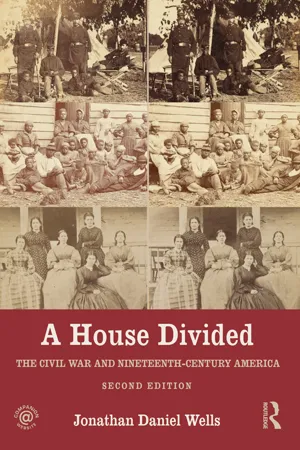History
Post Reconstruction South
The Post-Reconstruction South refers to the period following the Reconstruction era in the United States, roughly from the late 1870s to the early 1900s. This era was characterized by the rise of Jim Crow laws, which enforced racial segregation and disenfranchisement of African Americans, as well as the emergence of sharecropping as a dominant economic system. It was a time of significant social and political upheaval in the southern states.
Written by Perlego with AI-assistance
Related key terms
9 Key excerpts on "Post Reconstruction South"
- eBook - ePub
Sharing the Prize
The Economics of the Civil Rights Revolution in the American South
- Gavin Wright(Author)
- 2013(Publication Date)
- Belknap Press(Publisher)
CHAPTER 2THE POLITICAL ECONOMY OF THE JIM CROW SOUTHAbolition of slavery in the United States was swift and thorough, in contrast to other emancipations cushioned by gradualist timetables, compensation, or periods of apprenticeships. Slaves in the rebellious states were legally freed by the Emancipation Proclamation on New Year’s Day 1863, and this radical step was reaffirmed by the Thirteenth Amendment to the U.S. Constitution in 1865 and by the first state postwar constitutions under Presidential Reconstruction. The Fourteenth Amendment, granting citizenship and equal protection of the laws to freedmen, was ratified in 1868; the Fifteenth Amendment, prohibiting denial of the vote on the basis of “race, color or previous condition of servitude,” passed in 1870. Although these measures seemed definitive and were intended to be so at the time, the political and economic character of the postemancipation South was hotly contested for a full generation thereafter.It would not be accurate to say that the region settled into a new form of slavery. Labor mobility was high in the postbellum era, and the new systems of sharecropping and tenancy emerged as a kind of market-generated compromise between the freedmen’s goal of independence and the planters’ quest for cash crops. But the abandonment of plans to distribute land to the former slaves meant that blacks entered such contracts from a position of weakness. At the same time, high postwar cotton prices encouraged many smaller white farmers to take up cash-crop production. Subsequent stagnation in world cotton demand combined with high rates of population growth to bring blacks and many whites to a regional economic standard that was low relative to national norms. - Andrew Frank(Author)
- 2020(Publication Date)
- Routledge(Publisher)
For Douglass, Du Bois, and others, the most pressing issue after the American Civil War concerned the nearly four million former slaves who had recently obtained their freedom. Emancipation and citizenship—granted by the Thirteenth, Fourteenth, and Fifteenth Amendments—did not necessarily signify political, economic, or social equality for black Southerners. During the initial years of Reconstruction, President Johnson seemed unconcerned for the plight of the freedmen. Republican congressmen eventually wrested control from the executive branch and began to address some of the needs of Southern blacks. New policies protected the liberties of African-Americans and freed up federal funds to restructure the region. Southern blacks enjoyed access to the ballot box, and hundreds of black public officials were elected in the 1870s. Policies also protected the ability of Southern blacks to marry, file court cases, serve on juries, relocate, and obtain educations. African-American families who had been separated during slavery reunited, and thousands of former slaves formally changed their names to reflect their new freedom. In addition, Southern blacks formed independent churches, schools, fraternal organizations, equal rights leagues, and burial societies.The end of Reconstruction in 1877 was followed by a complete repudiation of these liberties. Southern blacks remained free in the New South era, but the meaning of this freedom was severely curtailed. Poll taxes, grandfather clauses, literacy tests, understanding clauses, and physical intimidation resulted in the complete disfranchisement of Southern blacks. Vagrancy laws restricted the mobility of blacks, and Jim Crow segregation laws brought racial inequality to nearly every aspect of Southern life. Interaction between the races was governed by an extensive code that expected blacks to be submissive, docile, and dependent. Lynchings and other forms of extralegal violence were used by Southern whites to enforce the region's new racial etiquette. Some blacks tried to escape the New South conditions by migrating north during World War I, but most African-Americans simply endured the postwar realities.The limited meaning of freedom for emancipated African-Americans resulted partly from the region's inequitable division of land. Black Southerners—with few exceptions—did not benefit from policies of land redistribution during Reconstruction or the New South. Former slaves received their freedom, but they primarily remained poor and landless. As a result, Southern blacks had few alternatives for employment other than working for the region's landed masters. Cultivation of cotton remained the region's central source of employment, and white landowners controlled this economic arena. The labor systems that emerged in the Reconstruction South and the New South—primarily sharecropping and tenant farming—brought black laborers and white landowners back together. In many ways, these labor systems resembled the Old South's system of slavery. White landowners limited the ability of their black fieldhands to negotiate better work conditions, and they used a system of debts to prevent their laborers from physically moving. AfricanAmericans attempted to shape this new labor system to their own desires by controlling their family's labor and by avoiding gang labor. Nevertheless, the inability of Southern blacks to purchase their own land severely curtailed their ability to make the New South look remarkably different from the Old.- eBook - ePub
Reconstruction Updated Edition
America's Unfinished Revolution, 1863-18
- Eric Foner(Author)
- 2014(Publication Date)
- Harper Perennial Modern Classics(Publisher)
85Thus, the gospel of prosperity failed in both its aims, for it produced neither a stable Republican majority nor a modernizing economy. Within Southern society, nonetheless, profound changes were underway, affecting the internal structure of the black and white communities and their relations with one another. Begun by the Civil War and emancipation, the transformation of Southern life was in some ways accelerated, in others redirected, by the years of Republican rule.Patterns of Economic Change
Slowly, a new social order took shape in the Reconstruction South. While far from the modernizing economy envisioned by Republican policymakers, it differed in crucial respects from its antebellum predecessor. The demise of slavery and the rapid spread of market relations in the predominantly white upcountry produced new systems of labor and new class structures among both black and white Southerners. The burden of history weighed heavily upon the South’s economic transformation, which took place in a war-torn, capital-scarce region that lacked the institutional base for sustained economic growth, faced a slowing world demand for its major export, and was excluded from a significant share of national political power. In retrospect, it appears all but inevitable that the postwar South would descend into a classic pattern of underdevelopment, its rate of economic growth and per capita income lagging far behind the rest of the nation. Yet the advent of Republican rule subtly affected the process of change, accelerating the commercialization of the Southern upcountry while increasing the freedmen’s bargaining power in the ongoing struggle over labor on the plantations.86 - Christopher McKnight Nichols, Nancy C. Unger, Christopher M. Nichols, Nancy C. Unger(Authors)
- 2017(Publication Date)
- Wiley-Blackwell(Publisher)
These visions of national reconciliation may be overplayed, however. As Carolyn Janney has argued (2013), the political reunification that occurred after the War hardly entailed a cultural reconciliation. Janney contends that union veterans did not forget the causes of the war, but, rather, celebrated their role in keeping the union together and in emancipating the slaves. That white northerners were also white supremacists was not a new development, for they had long separated their antipathy for slavery from their ideas about race. Some one hundred years later, the existences of a distinctive South is still debated, a sign that national reunification has perhaps not yet been achieved.References
- Ayers, Edward L. 1992. The Promise of the New South: Life after Reconstruction. New York: Oxford University Press.
- Bailey, Hugh C. 1969. Liberalism in the New South: Southern Social Reformers and the Progressive Movement. Coral Gables, FL: University of Miami Press.
- Billings, Dwight B. 1979. Planters and the Makings of a “New South”: Class, Politics, and Development in North Carolina, 1865–1900. Chapel Hill: University of North Carolina Press.
- Blackmon, Douglas A. 2008. Slavery by Another Name: The Re‐Enslavement of Black Americans from the Civil War to World War II. New York: Anchor Books.
- Blight, David W. 2002. Race and Reunion: The Civil War in American Memory. Cambridge, MA: Belknap Press/Harvard University Press.
- Blum, Edward J. 2007. Reforging the White Republic: Race, Religion, and American Nationalism, 1865–1898. Baton Rouge: Louisiana State University Press.
- Brown, Leslie. 2008. Upbuilding Black Durham: Gender, Class, and Black Community Development in the Jim Crow South. Chapel Hill: University of North Carolina Press.
- Brundage, W. Fitzhugh. 2011. “Introduction.” In The Folly of Jim Crow: Rethinking the Segregated South, ed. Stephanie Cole and Natalie J. Ring, 1–16. Arlington: Texas A & M Press for The University of Texas at Arlington.
- Carlton, David L. 1982. Mill and Town in South Carolina, 1880–1920. Baton Rouge: Louisiana State University Press.
- Cash, W. J. 1941. The Mind of the South. New York: A.A. Knopf.
- Cell, John Whitson. 1982. The Highest Stage of White Supremacy: The Origins of Segregation in South Africa and the American South. New York: Cambridge University Press.
- Clune, Erin Elizabeth. 2010. “From Light Copper to the Blackest and Lowest Type: Daniel Tompkins and the Racial Order of the Global New South.” The Journal of Southern History 76, 2: 275–314.
- Cobb, James C. 1984. Industrialization and Southern Society, 1877–1984
- eBook - ePub
- Lacy Ford, Lacy Ford(Authors)
- 2011(Publication Date)
- Wiley-Blackwell(Publisher)
Most of the historians writing about the postbellum reorganization of southern labor have been social historians. Although, like the economists, they have typically accepted the basic contours of the “standard scenario” of post-emancipation labor reorganization, differences of ideological orientation and disciplinary method have led them to strikingly different conclusions. To begin with the most obvious, in contrast to the predominant view among econometricians, social historians have been almost universally predisposed to interpret major historical developments as the outcome of the conflict between social groups rather than the decisions of individually oriented producers. The difference has been manifested most strikingly in the analyses of several historians who employed a Marxist framework. These scholars approached emancipation in the American South as part of a larger global trend toward the ascendancy of capitalist social relations. Within a year of the publication of One Kind of Freedom, two influential Marxist studies set forth such an interpretation and concluded that the prewar planter class had successfully preserved their control over labor and, as a result, postponed the triumph of liberal capitalism within the region. In The Roots of Black Poverty (1978), Jay R. Mandle attributed the persistent poverty of the former slaves to the survival of a low-wage plantation system after the Civil War. Events during the Reconstruction era demonstrated, in Mandle’s view, that the preservation of slavery was not essential to the preservation of the plantation system. Two factors were critical to its survival after emancipation: the failure of the federal government to distribute land among the freedmen, and the severely restricted employment opportunities for blacks in either southern or northern industry, due primarily to discriminatory hiring practices - eBook - ePub
A House Divided
The Civil War and Nineteenth-Century America
- Jonathan Wells(Author)
- 2016(Publication Date)
- Routledge(Publisher)
Equally important to the end of Reconstruction was the growing sense that the federal government had done much for the former slaves, from the Freedmen’s Bureau to the Reconstruction Amendments. Voters became fatigued with the notion of further aid for the freedpeople, and decided that with the right to vote African Americans could chart their own course without federal aid. Unfortunately, given southern white legal, political, and economic power, the ex-slaves stood little chance once the last federal troops began leaving the South in 1877. By the 1890s, whites had firmly established Jim Crow laws that left no doubt as to which race controlled the South.As Reconstruction collapsed, white southerners, most of them Democrats, regained political control of southern states, a process they called “Redemption.” In just a little over a decade, between 1865 and 1877, the nation underwent three phases: Presidential Reconstruction, Congressional or Radical Reconstruction, and Redemption. Those were years of turmoil but also years of remarkable progress for African Americans. With the completion of Redemption in 1877, however, the South’s course for the next century would be clearly charted: one-party Democratic control in politics, the triumph of white demagogues who preyed on fears of “racial amalgamation,” the subjugation of African Americans into low-paying jobs, the constant threat of lynching or other racial violence, and segregation in nearly every phase of public and private life.Republican Party Politics
During the period between 1866 and 1871, Radical Republicans had hefted the full weight of the federal government and its armed forces behind reconstructing the South. The Reconstruction Amendments, the Freedmen’s Bureau, the Military Reconstruction Acts, and laws to quash racial violence aided the freedpeople in practical and symbolic ways. Violence against blacks had quieted, although it lay just beneath the surface of southern society. Ex-slaves voted by the thousands, helping to elect a cadre of black politicians at the local, state, and national level. Former white Confederates were disfranchised and largely prevented from undertaking the worst expressions of racial control. Black literacy rates rose, as generations of former slaves learned in schools established by missionaries and the Freedmen’s Bureau. Southern Republicans for the first time appeared as a viable political power to compete with southern Democrats. The southern economy, though devastated beyond imagination by the war, received infusions of investments from northern capitalists. While the South faced real and mammoth problems, from seething white hostility at federal intervention to a wrecked economy and the loss of millions of dollars invested in slaves, the brief period known as Radical or Congressional Reconstruction had made substantial progress in creating a New South. - No longer available |Learn more
- (Author)
- 2013(Publication Date)
- Wiley-Blackwell(Publisher)
6 The Era of Reconstruction, 1865–1876What was to be the agenda for the country's future now that the Civil War had ended? Even the victorious Republican Party of the North held divergent views. One element within the party gave uppermost importance to granting citizenship to the newly freed slaves. These Radical Republicans, as they came to be called, were a distinct minority within the party in 1865, and they advocated extending full civil rights to ex-slaves, among them the franchise, education, and, possibly, ownership of confiscated Rebel land. Another, more moderate, faction within the Republican Party principally pursued economic development. During the course of the war, moderate Republicans succeeded in enacting a protective tariff, a plan of internal improvements (that is, improving transportation networks), a national banking system, and a homestead law that permitted the rapid settlement of the West. Backers of this agenda sought to keep southerners from undermining the vibrancy of an expanding national economy by their opposition to the new programs, their insistence on states' rights (the cornerstone of southern politics) and their demands for other concessions. Northern Democrats, not to be dismissed from determining the course of the nation, held still other views on the future of the postbellum United States. Nevertheless, nearly all Republicans believed that African Americans should, at the very least, have some measure of equality under the law.In April 1865, the war moved from the battlefield to the political arena. Texans, as did other southerners, sought to reestablish the Democratic rule that held sway before the war. Most urgent, for them, was to find a way to keep a newly freed black population (estimated by scholars to have numbered about 250,000) in subordination. In the differing goals of Republicans and southern Democrats lay the seeds of division and confrontation that would mark the era of Reconstruction. - eBook - ePub
- Robert A. Calvert, Arnoldo De Leon, Gregg Cantrell(Authors)
- 2020(Publication Date)
- Wiley-Blackwell(Publisher)
6 The Era of Reconstruction, 1865–1876What was to be the agenda for the country’s future now that the Civil War had ended? Even the victorious Republican Party of the North held divergent views. One element within the party gave uppermost importance to granting citizenship to the newly freed slaves. These Radical Republicans, as they came to be called, were a distinct minority within the party in 1865, and they advocated extending full civil rights to ex‐slaves, among them the franchise, education, and, possibly, ownership of confiscated Rebel land. Another, more moderate, faction within the Republican Party principally pursued economic development. During the course of the war, moderate Republicans succeeded in enacting a protective tariff, a plan of internal improvements (that is, improving transportation networks), a national banking system, and a homestead law that permitted the rapid settlement of the West. Backers of this agenda sought to keep southerners from undermining the vibrancy of an expanding national economy by their opposition to the new programs, their insistence on states’ rights (the cornerstone of southern politics), and their demands for other concessions. Northern Democrats, not to be dismissed from determining the course of the nation, held still other views on the future of the postbellum United States. Nevertheless, nearly all Republicans believed that African Americans should, at the very least, have some measure of equality under the law.In April 1865, the war moved from the battlefield to the political arena. Texans, as did other southerners, sought to reestablish the Democratic rule that held sway before the war. Most urgent, for them, was to find a way to keep a newly freed black population (estimated by scholars to have numbered about 250,000) in subordination. In the differing goals of Republicans and southern Democrats lay the seeds of division and confrontation that would mark the era of Reconstruction. - eBook - ePub
Civil War America
Making a Nation, 1848-1877
- Robert Cook(Author)
- 2014(Publication Date)
- Routledge(Publisher)
Even if the process of drawing up new constitutions highlighted the unifying impact of Democratic hostility on southern Republicans, it was evident from the start that the party would find it difficult to cohere on a permanent basis. Reconstruction had its greatest impact on areas in which blacks were in a majority. In many counties where plantation agriculture had thrived before the war, the combination of demographic strength, manhood suffrage, and a high-profile federal military presence gave blacks the opportunity to continue the process of community building. This was especially true in urban places where US troops and sympathetic army commanders were based, but even in the countryside African-Americans were able to reinforce their newly won freedom by sending children to school, participating in Republican meetings, going to the polls as first-class citizens, and serving on juries and as elected local officers. It was in the political sphere that the effects of Reconstruction were most visible.. Roughly 80 percent of southern Republican voters were black in the late 1860s and early 1870s. 35 If whites secured the lion’s share of public office in this period, sheer weight of numbers combined with a growing mood of assertiveness to ensure that African-Americans would begin to challenge that stranglehold. The extent of this political upheaval should not be exaggerated. No black governor was elected in any state and only in South Carolina did blacks come close to gaining their fair share of local offices. No more than 20 percent of public posts in the South were occupied by African-Americans at the height of Reconstruction. Few of these positions were at the federal level: only 6 percent of southern congressmen elected between 1868 and 1877 were black. More than 80 percent of these state and national officeholders were literate men. A disproportionate number of them were light-skinned and professional
Index pages curate the most relevant extracts from our library of academic textbooks. They’ve been created using an in-house natural language model (NLM), each adding context and meaning to key research topics.
